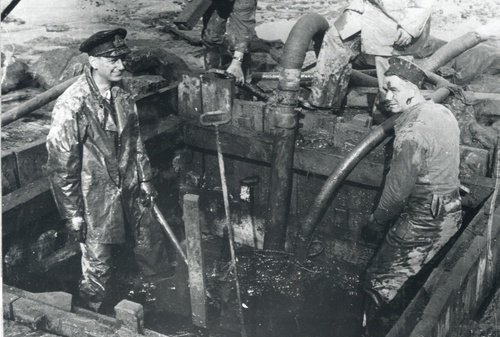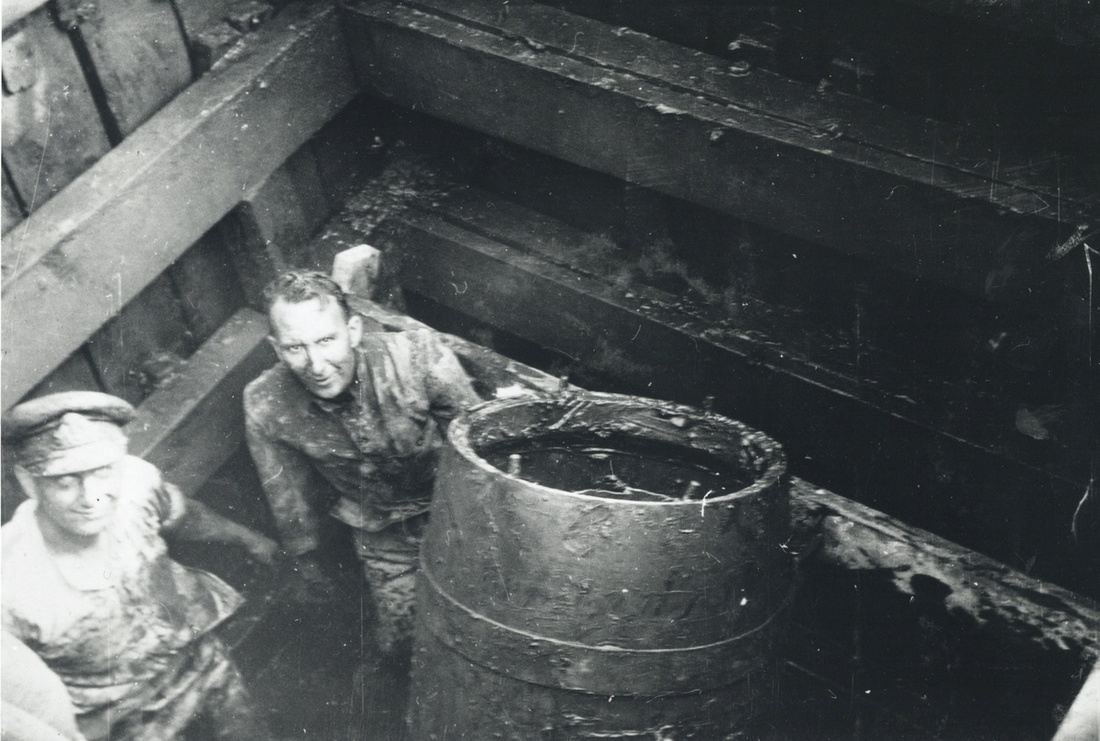Auction: 17002 - Orders, Decorations and Medals
Lot: 389
'Lieutenant Tanner, who was in charge of the operations, Lieutenant Peers and the seamen of the L.I.S. working under them were fully aware that this mine was probably in a highly dangerous state, and that when the mud was washed clear of the clock, the mine would possibly detonate … On the removal of the clock, it was found that the soluble plugs had melted but the clock had not run off. It started immediately on pressure being applied and the battery was in perfect condition … '
The recommendation for Lieutenant C. G. Tanner's George Medal, refers.
A rare and poignant Second World War mine disposal incident G.M. group of four awarded to Temporary Acting Lieutenant-Commander C. G. Tanner, Royal Naval Volunteer Reserve, who was killed whilst attempting to recover a G-type parachute mine from the wreckage of a Dornier 217 in Yorkshire in September 1943
His earlier courage in dismantling a brute of a parachute mine off Margaret Ness on the Thames in April 1942 was of an exceptional nature, the incident being the subject of extensive photographic coverage. In an epic battle of wits that lasted for five weeks, he worked in the 'most filthy and dangerous conditions' and in the full knowledge that 'there was no chance in getting away from the mine had anything occurred': on the last day of his heroic exertions - as he lay under the mine - the magnetic primer fell out and hit him in the face
George Medal, G.VI.R. (Lieut. Charles Graham Tanner, R.N.V.R.); 1939-45 Star; Atlantic Star; War Medal 1939-45, mounted in a family display frame with inlaid R.N. officer's button, together with remnants of his Admiralty condolence slip, this in the name of 'Temporary Acting Lieutenant-Commander Charles Graham Tanner, G.M., R.N.V.R.' and annotated in pencil, '64 UXB, 2 Mines', good very fine or better (4)
G.M. London Gazette 20 April 1943. The original recommendation states:
'On 20 March 1942, a parachute mine fell in the Thames off Margaret Ness. It was discovered through the parachute being seen in the mud at Low Water. The parachute was swept ashore on 30 March and removed by the Police who handed it to F.O.I.C. in London. The site is outside the Royal Woolwich Arsenal fence, and the Thames was buoyed to seaward to prevent shipping standing into danger. The sea wall at this point is a steep stone embankment rising some 20 ft. above the mud level.
There was a period of some 5 hours in which the site was uncovered, with an average depth of about 10 feet of water over it every tide, running at 4 knots up and down the river. It was therefore assumed that the mine was an Active Magnetic with a Mk. IV unit, as these mines were being dropped at the date of the fall. The mine was a potential danger to shipping in the Thames, the sea wall and the Royal Arsenal and it was decided to attempt to remove it.
On 6 October, operations were commenced to locate the mine. It was a laborious operation of probing in soft mud, in which the operators sank over their knees in soft black mud and could only cover 40 square yards per day.
After 10 days the mine was located with the tail 2 ft. below the surface of the mud lying at an angle of 38 degrees from the vertical, with the bomb fuse underneath. It was therefore necessary to excavate to a depth of about 9 ft. to deal with the fuse.
Lieutenant Tanner, who was in charge of the operations, Lieutenant Peers and the seamen of the L.I.S. working under them were fully aware that this mine was probably in a highly dangerous state, and that when the mud was washed clear of the clock, the mine would possibly detonate.
It was necessary to render the mine safe without moving it and Lieutenant Tanner decided to make an 8ft. hole, sinking all the runners to their full length in the mud in the form of a coffer dam before starting excavation, jetting the boards down by water pressure. The excavation was done by ejector-pump, but mud was deliberately left under the mine to prevent it moving. The mine was also supported on a cross-strut.
As soon as the detonator pocket, which was on top, was clear, Lieutenant Tanner, with the help of Able Seaman Fouracre, tried to unscrew the bung, but the bung would not move, and the tool broke when Lieutenant Tanner applied his full strength. The bung was obviously swollen in tight and was for practical purposes immovable.
Excavation was then proceeded with, and the following day the area for 400 yards was evacuated and shipping diverted to the Northern Shore. Lieutenant Peers cleared away the mud from the underside of the mine to the bomb fuse in order that Lieutenant Tanner could operate with clean hands. Lieutenant Tanner then attempted to render safe the mine, but found the bomb fuse badly corroded right down to the Hydrostatic Valve which he could not move in spite of pushing on it with all his strength with a screwdriver and he could not tell, owing to the corrosion, if it were already down.
As the only alternatives to removing the fuse were burning or steaming out with the fuse ungagged, he decided he was justified in taking the risk of removing the fuse ungagged, and this procedure was approved. He therefore carefully removed the keep ring and five attempts to pull the fuse out from a distance resulted in the cord breaking, as the fuse was firmly corroded in. The only way to get a straighter pull from the fuse was to pull the mine into a vertical position. Lieutenant Tanner therefore removed the Magnetic Primer. This was in perfect condition and in fact fell out on his face as he lay under the mine. The mine was then pulled vertical and a 2-inch block and tackle fitted to the extension ring on the fuse. On pulling this from a distance, the extension ring came off and sheared the threads on the fuse. Fortunately a steel extension fitting with adjustable jaws was available in the L.I.S. for this contingency. The next day this fitting was adjusted to what remained of the fuse, the 2-inch block and tackle secured, and at a distance 16 men manned the rope and walked slowly away. The rope tightened hard and then something appeared to snap. On returning to the mine Lieutenant Tanner found that the fuse had come out and he rendered the mine safe.
On the removal of the clock, it was found that the soluble plugs had melted but the clock had not run off. It started immediately on pressure being applied and the battery was in perfect condition.
This operation, which appeared almost hopeless from the beginning, lasted for five weeks. The party worked under the most filthy and dangerous conditions, and there was no chance of getting away from the mine should anything have occurred.'
Charles Graham Tanner, a graduate of Trinity College, Cambridge, was appointed a Temporary Lieutenant in the Royal Naval Volunteer Reserve (R.N.V.R.) in August 1940 and was serving in the Admiralty's Torpedo and Mines Department at the time of the above cited deeds. He received his G.M. at a Buckingham Palace investiture on 11 May 1943.
Lieutenant R. E. Peers, R.N.V.R., received a commendation and Able Seaman P. Fouracre, R.N., was awarded the B.E.M. Another rating, Acting Leading Seaman J. W. Collins, R.F.R., also received a commendation.
On 22 September 1943, Tanner was sent to deal with a pair of G-type parachute mines that had been located in the wreckage of a Dornier 217 in Yorkshire; the enemy aircraft had been coned by searchlights as it crossed the coast near Withernsea and hit the ground about a mile from Out Newton.
Tanner was accompanied by Percy Fouracre, his senior rating from the Thames incident in late 1942, together with Lieutenant F. H. E. Price, R.N.V.R. One of the G-types detonated, mortally wounding Tanner and Fouracre. Price was also wounded but survived. Robert Westall's much acclaimed book, The Machine Gunners, was based on this incident and was later serialised on the B.B.C.; see www.yorkshire-aircraft.co.uk
Tanner, who had been advanced to the temporary acting rank of Lieutenant-Commander, was aged 35 years. He is buried in Tilford (All Saints) Churchyard, near Farnham, Surrey.
Subject to 20% VAT on Buyer’s Premium. For more information please view Terms and Conditions for Buyers.
Sold for
£5,500









